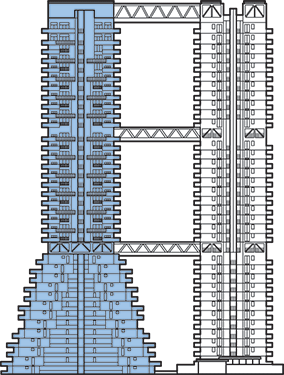Filter by
You must be a CTBUH Member to view this resource.

Sky Habitat Block 7
Building
Completed
2015
Residential
All-Concrete
BCA Green Mark Gold<sup>Plus</sup>
130.9 m / 429 ft
38
2
509
600
12
You must be a CTBUH Member to view this resource.
You must be a CTBUH Member to view this resource.
Proposed
Construction Start
Completed
Usually involved in the front end design, with a "typical" condition being that of a leadership role through either Schematic Design or Design Development, and then a monitoring role through the CD and CA phases.
Usually takes on the balance of the architectural effort not executed by the "Design Architect," typically responsible for the construction documents, conforming to local codes, etc. May often be referred to as "Executive," "Associate," or "Local" Architect, however, for consistency CTBUH uses the term "Architect of Record" exclusively.
The Design Engineer is usually involved in the front end design, typically taking the leadership role in the Schematic Design and Design Development, and then a monitoring role through the CD and CA phases.
The main contractor is the supervisory contractor of all construction work on a project, management of sub-contractors and vendors, etc. May be referred to as "Construction Manager," however, for consistency CTBUH uses the term "Main Contractor" exclusively.
You must be a CTBUH Member to view this resource.
Usually involved in the front end design, with a "typical" condition being that of a leadership role through either Schematic Design or Design Development, and then a monitoring role through the CD and CA phases.
Usually takes on the balance of the architectural effort not executed by the "Design Architect," typically responsible for the construction documents, conforming to local codes, etc. May often be referred to as "Executive," "Associate," or "Local" Architect, however, for consistency CTBUH uses the term "Architect of Record" exclusively.
The Design Engineer is usually involved in the front end design, typically taking the leadership role in the Schematic Design and Design Development, and then a monitoring role through the CD and CA phases.
The Design Engineer is usually involved in the front end design, typically taking the leadership role in the Schematic Design and Design Development, and then a monitoring role through the CD and CA phases.
The main contractor is the supervisory contractor of all construction work on a project, management of sub-contractors and vendors, etc. May be referred to as "Construction Manager," however, for consistency CTBUH uses the term "Main Contractor" exclusively.
Other Consultant refers to other organizations which provided significant consultation services for a building project (e.g. wind consultants, environmental consultants, fire and life safety consultants, etc).
2016 CTBUH Awards
2016 CTBUH Awards

31 October 2019 | Singapore
Moshe Safdie, Founder at Safdie Architects, speaks at the 2019 CTBUH International Congress in Chicago on 31 October 2019.

17 October 2016
Stephan Reinke, Stephan Reinke Architects Limited
How does the 21st Century youth culture of social media integrate and merge with an ever increasing tech savvy senior population? As our cities and...

31 October 2019 | Singapore
Moshe Safdie, Founder at Safdie Architects, speaks at the 2019 CTBUH International Congress in Chicago on 31 October 2019.

26 October 2015 | Singapore
Though the skyscraper has been with us for a century, we are yet to discover how to deploy it as an effective building block for...

21 September 2012 | Singapore
Safdie Architects has developed principles for high-rise, mixed-use developments around the world, and specifically in Asia, where they build upon both past experience as well...

17 October 2016
Stephan Reinke, Stephan Reinke Architects Limited
How does the 21st Century youth culture of social media integrate and merge with an ever increasing tech savvy senior population? As our cities and...
SafdieArchitects.jpg)
04 February 2016
Jaron Lubin, Safdie Architects
The principles set forth 48 years ago at the Montreal Expo 1967, embodied in the form of Habitat ’67, which proposed an entirely different kind...

21 September 2012
Jaron Lubin, Safdie Architects
A key principle of Moshe Safdie’s work over the last four decades has been to develop livable collective spaces within dense urban environments. This paper...
Subscribe below to receive periodic updates from CTBUH on the latest Tall Building and Urban news and CTBUH initiatives, including our monthly newsletter. Fields with a red asterisk (*) next to them are required.
View our privacy policy